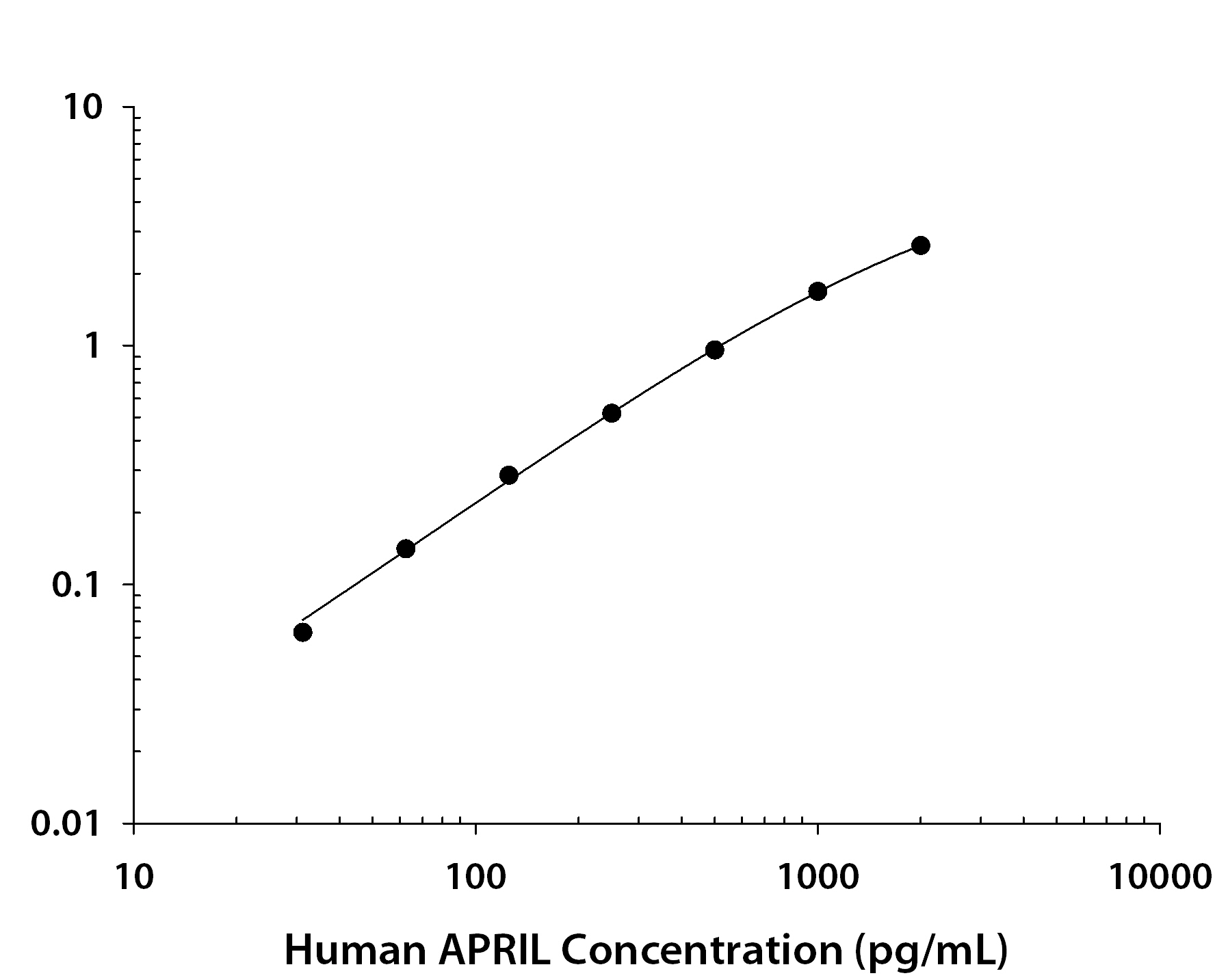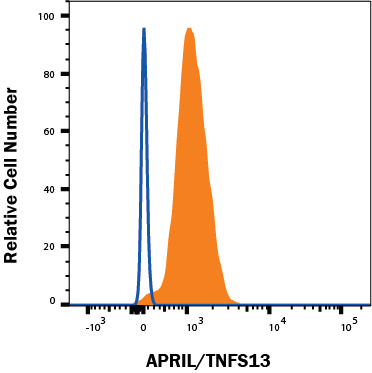Human APRIL/TNFSF13 Antibody Summary
Applications
This antibody functions as an ELISA detection antibody when paired with Mouse Anti-Human APRIL/TNFSF13 Monoclonal Antibody (Catalog # MAB8844).
This product is intended for assay development on various assay platforms requiring antibody pairs. We recommend the Human APRIL/TNFSF13 DuoSet ELISA Kit (Catalog # DY884B) for convenient development of a sandwich ELISA.
Please Note: Optimal dilutions should be determined by each laboratory for each application. General Protocols are available in the Technical Information section on our website.
Scientific Data
 View Larger
View Larger
Human APRIL/TNFSF13 ELISA Standard Curve. Recombinant Human APRIL/TNFSF13 protein was serially diluted 2-fold and captured by Mouse Anti-Human APRIL/TNFSF13 Monoclonal Antibody (MAB8844) coated on a Clear Polystyrene Microplate (DY990). Goat Anti-Human APRIL/TNFSF13 Antigen Affinity-purified Polyclonal Antibody (Catalog # AF884) was biotinylated and incubated with the protein captured on the plate. Detection of the standard curve was achieved by incubating Streptavidin-HRP (DY998) followed by Substrate Solution (DY999) and stopping the enzymatic reaction with Stop Solution (DY994).
 View Larger
View Larger
Detection of APRIL/TNFSF13 in U937 Human Cell Line by Flow Cytometry. U937 human lymphoma cell line was stained with Goat Anti-Human APRIL/TNFSF13 Antigen Affinity-purified Polyclonal Antibody (Catalog # AF884, filled histogram) or control antibody staining (AB-108-C, open histogram) followed by anti-Goat IgG PE-conjugated Secondary Antibody (F0107). To facilitate intracellular staining, cells were fixed with Flow Cytometry Fixation Buffer (FC004) and permeabilized with Flow Cytometry Permeabilization/Wash Buffer I (FC005). View our protocol for Staining Intracellular Molecules.
Reconstitution Calculator
Preparation and Storage
- 12 months from date of receipt, -20 to -70 °C as supplied.
- 1 month, 2 to 8 °C under sterile conditions after reconstitution.
- 6 months, -20 to -70 °C under sterile conditions after reconstitution.
Background: APRIL/TNFSF13
APRIL (a proliferation-inducing ligand), also known as TNFSF13, TALL2, and TRDL1, is a member of the TNF ligand superfamily (1). APRIL is synthesized as a 32 kDa type II transmembrane protein which is cleaved by furin in the Golgi to release a 17 kDa soluble molecule (2, 3). Secreted APRIL consists almost entirely of a single TNF homology domain (2, 3). Little or no transmembrane APRIL is expressed on the cell surface (3). Alternate splicing generates isoforms with short deletions at the N- or C-terminus (4). Human APRIL shares 85% aa sequence identity with mouse and rat APRIL. Among TNF superfamily ligands, BAFF shows the greatest sequence homology with APRIL, and the two proteins exhibit overlapping biological activities. APRIL promotes cellular proliferation and protects from apoptosis in normal and transformed cells (3, 5‑7). It is present in elevated amounts in a wide variety of cancers primarily due to expression by tumor-infiltrating neutrophils (4, 5, 7‑9). Both APRIL and BAFF bind and signal through the TNF superfamily receptors TACI and BCMA, and BAFF additionally functions through BAFF R (6, 10, 11). A stretch of basic amino acids at the N-terminus of APRIL is required for its interaction with heparan sulfate proteoglycans (HSPGs) (12, 13). Binding to HSPGs is independent of APRIL’s binding to TACI and BCMA (12, 13). Interaction with HSPGs serves to concentrate APRIL on the surface of cells, thereby favoring TACI- or BCMA-mediated effects (8, 9, 13). APRIL can form bioactive heterotrimers with BAFF, and these circulate in the serum of patients with rheumatic immune disorders (14). A bioactive protein known as TWE-PRIL consists of the intracellular domain, transmembrane segment, and stalk region of TWEAK fused to the TNF homology domain of APRIL (15). TWE-PRIL is expressed in monocytes and activated T cells, and in contrast to APRIL, it is presented on the cell surface (15).
- Planelles, L. et al. (2008) Curr. Mol. Med. 8:829.
- Hahne, M. et al. (1998) J. Exp. Med. 188:1185.
- Lopez-Fraga, M. et al. (2001) EMBO Reports 2:945.
- Kelly, K. et al. (2000) Cancer Res. 60:1021.
- Roth, W. et al. (2001) Cell Death Differ. 8:403.
- Yu, G. et al. (2000) Nat. Immunol. 1:252.
- He, B. et al. (2004) J. Immunol. 172:3268.
- Schwaller, J. et al. (2007) Blood 109:331.
- Mhawech-Fauceglia, P. et al. (2008) Eur. J. Cancer 44:2097.
- Day, E.S. et al. (2005) Biochemistry 44:1919.
- Bossen, C. et al. (2006) J. Biol. Chem. 281:13964.
- Hendriks, J. et al. (2005) Cell Death Differ. 12:637.
- Ingold, K. et al. (2005) J. Exp. Med. 201:1375.
- Roschke, V. et al. (2002) J. Immunol. 169:4314.
- Pradet-Balade, B. et al. (2002) EMBO J. 21:5711.
Product Datasheets
Citations for Human APRIL/TNFSF13 Antibody
R&D Systems personnel manually curate a database that contains references using R&D Systems products. The data collected includes not only links to publications in PubMed, but also provides information about sample types, species, and experimental conditions.
3
Citations: Showing 1 - 3
Filter your results:
Filter by:
-
BDNF belongs to the nurse-like cell secretome and supports survival of B chronic lymphocytic leukemia cells
Authors: H Talbot, S Saada, E Barthout, PF Gallet, N Gachard, J Abraham, A Jaccard, D Troutaud, F Lalloué, T Naves, AL Fauchais, MO Jauberteau
Sci Rep, 2020-07-28;10(1):12572.
Species: Human
Sample Types: Recombinant Protein, Whole Cells
Applications: ICC, Western Blot -
Macrophages induce differentiation of plasma cells through CXCL10/IP-10.
J. Exp. Med., 2012-09-17;209(10):1813-23.
Species: Human
Sample Types: Whole Cells
Applications: Flow Cytometry -
BAFF and APRIL protect myeloma cells from apoptosis induced by interleukin 6 deprivation and dexamethasone.
Authors: Moreaux J, Legouffe E, Jourdan E, Quittet P, Reme T, Lugagne C, Moine P, Rossi JF, Klein B, Tarte K
Blood, 2003-12-04;103(8):3148-57.
Species: Human
Sample Types: Serum
Applications: ELISA Development
FAQs
No product specific FAQs exist for this product, however you may
View all Antibody FAQsReviews for Human APRIL/TNFSF13 Antibody
There are currently no reviews for this product. Be the first to review Human APRIL/TNFSF13 Antibody and earn rewards!
Have you used Human APRIL/TNFSF13 Antibody?
Submit a review and receive an Amazon gift card.
$25/€18/£15/$25CAN/¥75 Yuan/¥2500 Yen for a review with an image
$10/€7/£6/$10 CAD/¥70 Yuan/¥1110 Yen for a review without an image


